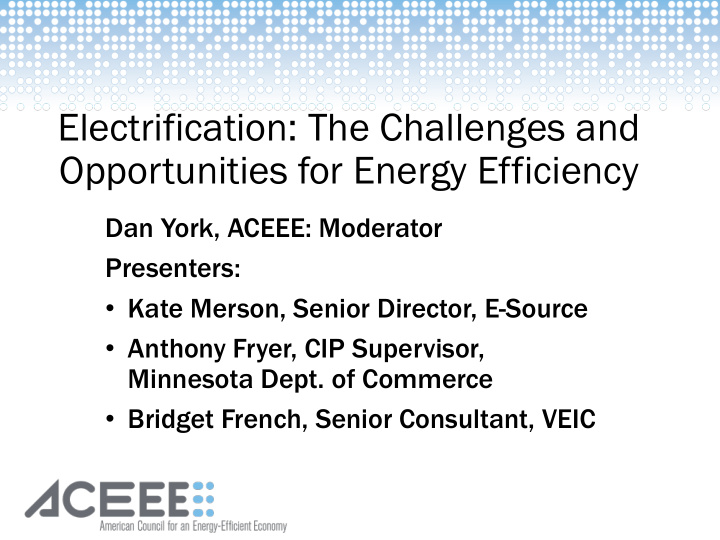



Electrification: The Challenges and Opportunities for Energy Efficiency Dan York, ACEEE: Moderator Presenters: • Kate Merson, Senior Director, E-Source • Anthony Fryer, CIP Supervisor, Minnesota Dept. of Commerce • Bridget French, Senior Consultant, VEIC
Some definitions Electri ectrificatio ication n is a form of fuel switching that either fully or partially displaces direct fossil fuel use with electricity use, e.g. moving from an oil or gas furnace to electric heat pumps; Benef neficial icial elect ectri rification ication (BE) E) (or strategic electrification): electrification that provides societal benefits, e.g. by reducing overall emissions, energy & customer costs and improving grid management
Beneficial electrification is a form of energy efficiency when it meets three criteria: Electrification 1. Saves total energy in source Btu’s Beneficial electrification 2. Saves consumers money 3. Reduces emissions Energy efficiency as a form of BE often means shifting to beneficial energy-efficient technologies, electrification e.g. electric vehicles (EVs) and high-efficiency heat pumps
• Decarbonization opportunities from electrification vary by customer or building type, region principles and over time when • Electrification criteria and potential should be analyzed considering under local conditions the role of • Align equipment programs with whole-building/whole-house beneficial upgrades to reduce energy demands, e.g. staged programs electrification • Electrification costs generally lower if done when existing equipment fails and needs to be replaced
• ACEEE Blog post: Electrification and Efficiency: Crafting an Enduring Relationship • Energy Efficiency For All and Greenlining Additional Institute, Sept. 2019: Equitable Resources Buildings Electrification: A Framework for Powering Resilient Communities • EESI Report: Equitable Beneficial Electrification for Rural Electric Cooperatives
Recommend
More recommend